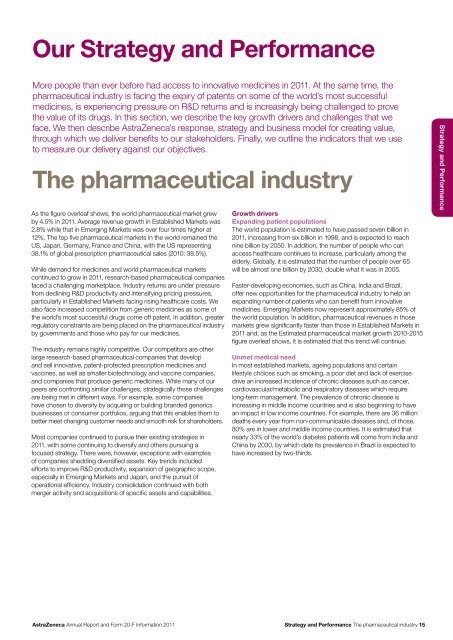AstraZeneca Annual Report and Form 20-F Information 2011
AstraZeneca Annual Report and Form 20-F Information 2011
AstraZeneca Annual Report and Form 20-F Information 2011
- No tags were found...
Create successful ePaper yourself
Turn your PDF publications into a flip-book with our unique Google optimized e-Paper software.
Our Strategy <strong>and</strong> PerformanceMore people than ever before had access to innovative medicines in <strong>20</strong>11. At the same time, thepharmaceutical industry is facing the expiry of patents on some of the world’s most successfulmedicines, is experiencing pressure on R&D returns <strong>and</strong> is increasingly being challenged to provethe value of its drugs. In this section, we describe the key growth drivers <strong>and</strong> challenges that weface. We then describe <strong>AstraZeneca</strong>’s response, strategy <strong>and</strong> business model for creating value,through which we deliver benefits to our stakeholders. Finally, we outline the indicators that we useto measure our delivery against our objectives.The pharmaceutical industryAs the figure overleaf shows, the world pharmaceutical market grewby 4.5% in <strong>20</strong>11. Average revenue growth in Established Markets was2.8% while that in Emerging Markets was over four times higher at12%. The top five pharmaceutical markets in the world remained theUS, Japan, Germany, France <strong>and</strong> China, with the US representing38.1% of global prescription pharmaceutical sales (<strong>20</strong>10: 38.5%).While dem<strong>and</strong> for medicines <strong>and</strong> world pharmaceutical marketscontinued to grow in <strong>20</strong>11, research-based pharmaceutical companiesfaced a challenging marketplace. Industry returns are under pressurefrom declining R&D productivity <strong>and</strong> intensifying pricing pressures,particularly in Established Markets facing rising healthcare costs. Wealso face increased competition from generic medicines as some ofthe world’s most successful drugs come off patent. In addition, greaterregulatory constraints are being placed on the pharmaceutical industryby governments <strong>and</strong> those who pay for our medicines.The industry remains highly competitive. Our competitors are otherlarge research-based pharmaceutical companies that develop<strong>and</strong> sell innovative, patent-protected prescription medicines <strong>and</strong>vaccines, as well as smaller biotechnology <strong>and</strong> vaccine companies,<strong>and</strong> companies that produce generic medicines. While many of ourpeers are confronting similar challenges, strategically these challengesare being met in different ways. For example, some companieshave chosen to diversify by acquiring or building br<strong>and</strong>ed genericsbusinesses or consumer portfolios, arguing that this enables them tobetter meet changing customer needs <strong>and</strong> smooth risk for shareholders.Most companies continued to pursue their existing strategies in<strong>20</strong>11, with some continuing to diversify <strong>and</strong> others pursuing afocused strategy. There were, however, exceptions with examplesof companies shedding diversified assets. Key trends includedefforts to improve R&D productivity, expansion of geographic scope,especially in Emerging Markets <strong>and</strong> Japan, <strong>and</strong> the pursuit ofoperational efficiency. Industry consolidation continued with bothmerger activity <strong>and</strong> acquisitions of specific assets <strong>and</strong> capabilities.Growth driversExp<strong>and</strong>ing patient populationsThe world population is estimated to have passed seven billion in<strong>20</strong>11, increasing from six billion in 1998, <strong>and</strong> is expected to reachnine billion by <strong>20</strong>50. In addition, the number of people who canaccess healthcare continues to increase, particularly among theelderly. Globally, it is estimated that the number of people over 65will be almost one billion by <strong>20</strong>30, double what it was in <strong>20</strong>05.Faster-developing economies, such as China, India <strong>and</strong> Brazil,offer new opportunities for the pharmaceutical industry to help anexp<strong>and</strong>ing number of patients who can benefit from innovativemedicines. Emerging Markets now represent approximately 85% ofthe world population. In addition, pharmaceutical revenues in thosemarkets grew significantly faster than those in Established Markets in<strong>20</strong>11 <strong>and</strong>, as the Estimated pharmaceutical market growth <strong>20</strong>10-<strong>20</strong>15figure overleaf shows, it is estimated that this trend will continue.Unmet medical needIn most established markets, ageing populations <strong>and</strong> certainlifestyle choices such as smoking, a poor diet <strong>and</strong> lack of exercisedrive an increased incidence of chronic diseases such as cancer,cardiovascular/metabolic <strong>and</strong> respiratory diseases which requirelong-term management. The prevalence of chronic disease isincreasing in middle income countries <strong>and</strong> is also beginning to havean impact in low income countries. For example, there are 36 milliondeaths every year from non-communicable diseases <strong>and</strong>, of those,80% are in lower <strong>and</strong> middle income countries. It is estimated thatnearly 33% of the world’s diabetes patients will come from India <strong>and</strong>China by <strong>20</strong>30, by which date its prevalence in Brazil is expected tohave increased by two-thirds.Strategy <strong>and</strong> Performance<strong>AstraZeneca</strong> <strong>Annual</strong> <strong>Report</strong> <strong>and</strong> <strong>Form</strong> <strong>20</strong>-F <strong>Information</strong> <strong>20</strong>11Strategy <strong>and</strong> Performance The pharmaceutical industry 15










